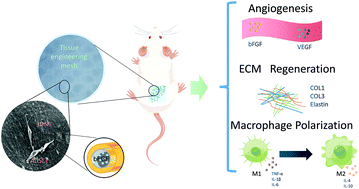Adipose mesenchymal stem cell-based tissue engineering mesh with sustained bFGF release to enhance tissue repair
Abstract
Pelvic organ prolapse (POP) harms the quality of life of elderly patients. Transvaginal polypropylene mesh repair for POP was a frequently reported complication and was banned by the FDA in 2019. New therapeutic strategies are urgently required, and tissue engineering technology could be a novel therapy. Here, we developed a tissue engineering mesh out of three components: silk fibroin (SF) knitted mesh loaded with basic fibroblast growth factor (bFGF) and adipose-derived stem cells (ADSCs). We used coaxial electrospinning technology to achieve local bFGF release to promote regeneration. Additionally, ADSCs were loaded to demonstrate their paracrine ability of immune regulation and angiogenesis. Meanwhile, knitted silk fibroin mesh provided mechanical support. In vitro, SF/bFGF/ADSC tissue engineering mesh can stably release bFGF and has good biocompatibility, promoting cell proliferation and extracellular matrix synthesis. Six months after the SF/bFGF/ADSC tissue engineering mesh was implanted in a SD rat model, extracellular matrix reorganization, angiogenesis, and immunomodulatory effect, as well as mechanical properties of the implanting position were improved. Hence, SF/bFGF/ADSC tissue engineering mesh could be regarded as a promising option with excellent collagen synthesis, low foreign body response, and early angiogenic ability, providing potential ideas for POP treatment.



 Please wait while we load your content...
Please wait while we load your content...